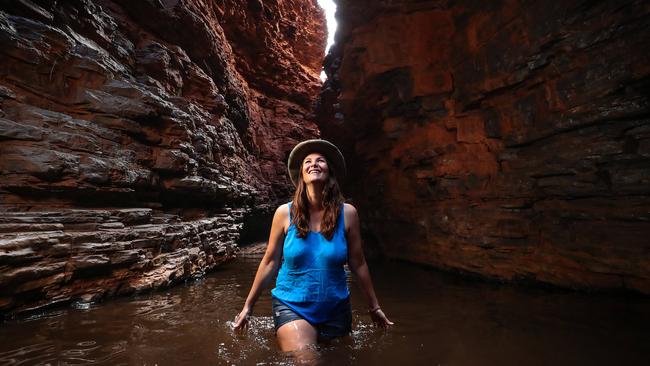Wilderness experience resurrects tourist influx
A flagging industry is being resurrected as Easter holiday tourists flock to Karijini National Park in the Pilbara.

In Western Australia’s remote and dramatic wilderness, a flagging industry is being resurrected as Easter holiday tourists flock to Karijini National Park, in the rugged heart of the Pilbara region.
They have come for the Karijini Experience, a 10-day festival held over the school holiday break on Banjima country in WA’s second-biggest national park.
Tourism has languished in the resource-rich state for years, as leisure visitors were squeezed out by inflated boom-era prices and thousands of resource construction workers filled every spare room from Perth to Broome. For a time, even the Eco Retreat luxury tents nestled alongside Karijini’s stunning ironstone gorges attracted mainly fly-in, fly-out mine workers needing accommodation.
Now the Cinderella state is celebrating a tourism turnaround and a record number of interstate and international visitors.
While Western Australia ranks fourth among the nation’s destination states, the latest National Visitor Survey released today shows WA’s tourist growth in the past year has exceeded all states, with a 17.8 per cent rise in interstate visitors since 2017 numbers. Combined with last month’s release of the International Visitor Survey, WA attracted 2.58 million visitors last year, the highest amount in the past four years and an increase of 11.4 per cent on the previous year. In 2017, overseas visitor numbers to WA rose 1.1 per cent, with only the Northern Territory experiencing a worse year-on-year change.
Tourism Minister Paul Papalia said Western Australia had started to turn around a dismal tourism legacy from the resource boom era “when we had the most expensive hotel rooms in the country, the costliest cup of coffee and a poor international reputation”.
He said Karijini, where he attended the festival’s first few days, epitomises the state’s new two-year tourism strategy of selling “a geographic advantage nobody can take away from us”.
The government launched a global Road Trips campaign last year to promote adventurous driving holidays to a special natural destination. At Karijini this weekend, there’s the added bonus of corroborees, bush-tucker walks and song sessions centred around ancient culture in two billion-year-old rock gorges.
Local man Wesley Carey, whose Banjima Native Title Aboriginal Corporation is the main sponsor of the event, said sharing culture on country was an economic activity that created future jobs for four-year-old son Kayson’s generation.
“I’m someone who is willing to share our culture, and tourism fits in with that,” said the 34-year-old father, who also works as a trades assistant for a mining subcontractor.
Performing at the Karijini Experience gives residents of nearby mining towns such as Tom Price and Paraburdoo a glimpse of the cultural life of the park’s traditional owners. It also gave Mr Carey a rare opportunity to educate his Pilbara boss, who was in the audience during the Welcome to Country performance. “I invited him along because he’d never seen a corroboree before and he was blown away,” Carey said. “He said he could see I was a good leader.”
From April to October, Karijini attracts about 50,000 visitors before monsoonal rains arrive and flood the walk trails inside Weano, Hancock, Kalamina and Fortescue gorges. Beds of banded iron stone give vivid colour to rocks with a geological age of up to 2500 million years.
Bush radio DJ Angie Ayers, who hosted the festival’s events, said: “The Karijini Experience captures a unique blending of cultures and storytelling.”
The Weekend Australian visited Karijini as a guest of Tourism WA



To join the conversation, please log in. Don't have an account? Register
Join the conversation, you are commenting as Logout